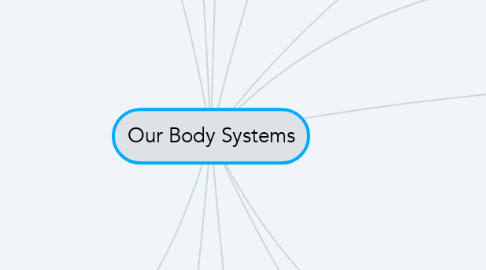
1. Respiratory System
1.1. Functions
1.1.1. Transports oxygen around the body
1.1.2. Removes Carbon Dioxide from the body to the outside
1.1.3. Enables the gaseous exchange process
1.2. Components
1.2.1. Muscles
1.2.1.1. Intercostal
1.2.1.2. Diaphragm
1.2.2. Airways
1.2.2.1. Nose
1.2.2.2. Larynx
1.2.2.3. Trachea
1.2.2.4. Bronchioles
1.2.2.5. Bronchi
1.2.2.6. Pharynx
1.2.2.7. Mouth
1.2.3. Lungs
2. Lymphatic System
2.1. Functions
2.1.1. Helps fight disease
2.1.2. Transport fatty acids from the intestines to the cardiovascular system
2.1.3. Get rid of toxins, waste and unwanted substances from the body
2.1.4. Transfer lymph (fluid containing white blood cells) around the body
2.2. Components
2.2.1. Lymph
2.2.2. Lymph Vessels
2.2.3. Lymph nodes
2.2.4. Adenoids
2.2.5. Spleen
2.2.6. Thymus
3. Muscuolo-skeletal System
3.1. Components
3.1.1. Muscles
3.1.1.1. Cardiac - heart
3.1.1.2. Skeletal - attach muscle to bones
3.1.1.3. Smooth - control internal processes
3.1.2. Bones
3.1.2.1. There are 206 bones in our bodies
3.1.2.1.1. Shapes
3.1.2.1.2. Types
3.2. Function
3.2.1. Allow movement
3.2.2. Produce heat
3.2.3. Produce blood cells
3.2.4. Give shape and structure
3.2.5. Store calcium and phosphorus
3.2.6. Protect and support organs
4. Endocrine System
4.1. Components
4.1.1. Thymus
4.1.2. Hypothalamus
4.1.3. Adrenal Gland
4.1.4. Pancreas
4.1.5. Gonads
4.1.6. Pituitary Gland
4.1.7. Pineal Gland
4.1.8. Thyroid Gland
4.2. Function
4.2.1. Controls homeostasis
4.2.2. Controls all the glands and the hormones they produce
4.2.3. Controls metabolism
4.2.4. Controls sexual development
5. Cardiovascular System
5.1. Functions
5.1.1. Regulation of our body temperature - homeostasis
5.1.2. Protects via white blood cells
5.1.3. Transporting oxygen, hormones, nutrients and waste products around the body
5.2. Components
5.2.1. Blood cells
5.2.2. Veins
5.2.3. Heart
5.2.4. Arteries
6. Nervous System
6.1. Components
6.1.1. Spinal cord
6.1.2. Brain
6.1.3. Sense organs
6.1.4. Nerves
6.2. Functions
6.2.1. Receive, transmit and integrate information from the inside and outside
6.2.1.1. Brain - consciousness, memory, decision-making, involuntary and voluntary contractions
6.2.1.2. Spinal Cord - carries info down the body which causes reflexes
6.2.1.3. Nerves - carries all the information
7. Digestive System
7.1. Components
7.1.1. Pancreas
7.1.2. Liver
7.1.3. Oesophagus
7.1.4. Stomach
7.1.5. Small and large intestine
7.1.6. Mouth
8. Functions
8.1. Consumption and digestive of food
8.2. Allows for food not digested to leave the body as faeces
8.3. Absorption of nutrients into the bloodstream
8.3.1. Fats
8.3.2. Vitamins
8.3.3. Carbohydrates
8.3.4. Protein
9. Urinary System
9.1. Functions
9.1.1. Removal of wastes and toxins via urine
9.2. Components
9.2.1. Kidneys
9.2.2. Ureters
9.2.3. Bladder
10. Reproductive System
10.1. Function
10.1.1. To create new life
10.2. Components
10.2.1. Male
10.2.1.1. Testes
10.2.1.2. Glands
10.2.1.3. Sperm ducts
10.2.1.4. Urethra and penis
10.2.2. Female
10.2.2.1. Ovarians
10.2.2.2. Cervix
10.2.2.3. Vagina
10.2.2.4. Uterus
10.2.2.5. Fallopian tubes
11. Integumentary System
11.1. Function
11.1.1. Protects the internal parts from damage
11.1.2. Prevent dehydration
11.1.3. Stores fat
11.1.4. Produce hormones and minerals
11.2. Components
11.2.1. Blood and lymph vessels
11.2.2. Nails
11.2.3. Hair
11.2.4. Sweat and Oil Glands
11.2.5. Nerves
11.2.6. Muscles
